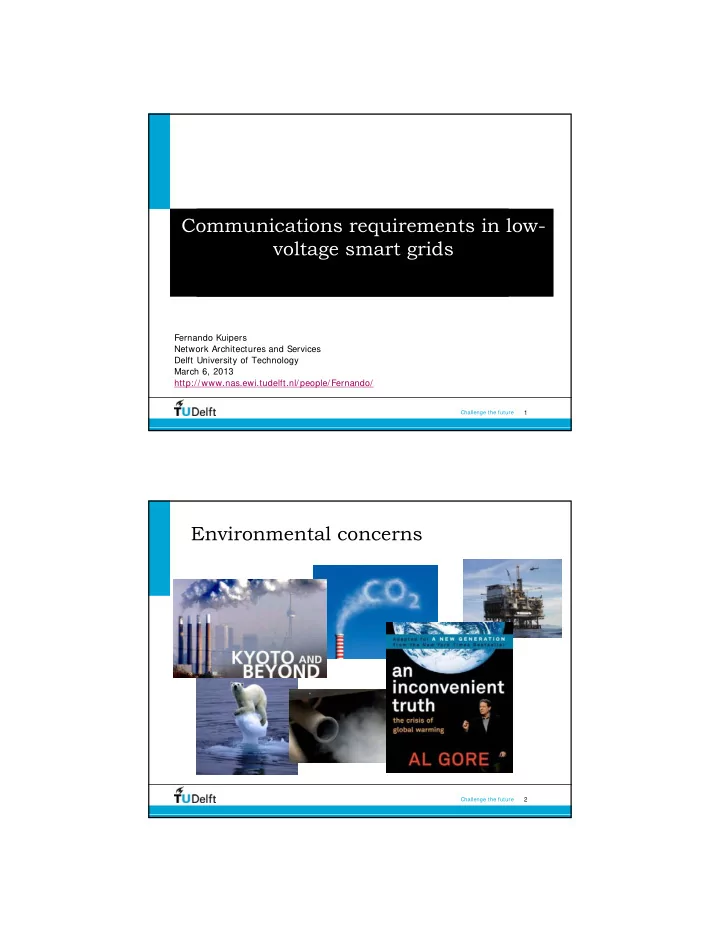

Communications requirements in low- voltage smart grids Fernando Kuipers Network Architectures and Services Delft University of Technology March 6, 2013 http://www.nas.ewi.tudelft.nl/people/Fernando/ Challenge the future 1 Environmental concerns Challenge the future 2
Towards smart grids Challenge the future 3 ICT needed to make the grid smart Challenge the future 4
Focus on LV networks Big Energy Farms Few Nodes already have telecom HV ~ 100 Being digitized Moderate Nodes MV ~ 10.000 No clear idea Many Nodes about telecom LV ~ 10.000.00 needs 0 Challenge the future 5 Challenges • Integration and intermittency of renewable generators • Load balancing, energy storage • Integration of new energy consumers: Electrical Vehicles and Heat pumps • Peak shaving • Energy trading by former consumers • Prosumers, energy brokers, … • Physical limitations of the power grid • Voltage and congestion control • Multi-layer dependencies • Multi-layer control Challenge the future 6
Balancing problems Match consumption with generation Wind Sun Match consumption with available wind and sun power Challenge the future 7 Avoiding peaks Peak shaving Challenge the future 8
Voltage and congestion problem Challenge the future 9 Communication time requirements • Load balancing and Peak shaving • In the order of minutes • E.g. PowerMatcher • Local power exchanges • Communicating price signals in the order of minutes • Voltage and congestion control • Directly linked with safety of the grid • Voltage and load vary real-time • Sub-second response time requirement Challenge the future 10
Experiments V&C control • We consider a low voltage (LV) grid with prosumer households • Based on study of distribution networks: • Representative LV network selected • Considered (futuristic) scenarios: • Solar panels at each house • Electric vehicle at each house Challenge the future 11 Experiment one: PV A cloud passes a neihborhood with PV Challenge the future 12
Results PV experiment • Used an annual 1 Hz frequency solar radiation dataset • Selected periods showing extreme variations • 600 ms from 80% of overvoltage (248 V) to the maximum • 500 ms from 80% load to maximum capacity • Overvoltage burns fuses, brief overload is tolerable Challenge the future 13 Experiment two: EV Time at which charging of electrical vehicles begins Challenge the future 14
Results EV experiment • EV charged as soon as it 235 1 EV arrives at home 230 3 EVs • EVs start to charge in the Voltage level (V) 5 EVs same second (Figure) 220 7 EVs 210 9 EVs 200 1 2 3 4 Time step (s) • Chances are very small that 2 or more start to charge in the same second • The EV load dynamics pose less constraints on the response time for voltage and congestion control Challenge the future 15 Response time constituents For a centralized control scheme: 1. Measurement time: 10 ms 2. Upward communication time 3. Computation time: about 5 ms 4. Downward communication time 5. Control time: about 5 ms • Communication time (2 and 4) at 80% overvoltage • Communication Latency = ( 600 ms - 20 ms)/2 = 290 ms Trigger point (% overvoltage) 40 50 60 70 90 95 Latency constraint (ms) 990 740 490 390 90 25 Challenge the future 16
PowerWeb • TUDelft interdisciplinary research consortium working on the challenges in realizing a robust and reconfigurable smart energy grid • Steering board: • Prof. Lou van der Sluis • Prof. Paulien Herder • Dr. Fernando Kuipers • Prof. Kees Vuik • Prof. Cees Witteveen • Industry: • Alliander, Tennet, TNO, Siemens, Phase2Phase, JRC Petten, … Challenge the future 17 PowerWeb overview A system of energy prosumers, Cluster 2: The smart grid as subjected to governmental regulations a complex socio-technical system Cluster 3: A system of systems having to meet overall robustness criteria and Smart grid being able to reconfigure itself if control necessary Cluster 1: Building blocks for a Real-time power control system flexible smart grid infrastructure optimizing functions in relation to physical infrastructure and environment Challenge the future 18
Cluster 1: Smart grid infrastructure • Observation: Power grid is rapidly changing (distributed renewable sources) and increasingly complex to manage • Challenges: • How to model the changing grid and its physical properties? • How to ensure stability? • First steps: • Efficient solvers to compute transients in power grids • Quantify operational limits of smart grid • Build simulators Challenge the future 19 Cluster 2: Smart grid and society • Observation: The smart grid is a complex socio-technical system governed by “prosumers” and government • Challenge: • To identify the right institutional and market concepts to predict and control the smart grid as a dynamic multi-actor system • First steps: • Multi-actor model to capture relationships between changes in the energy supply, demand patterns or regulations and prosumer behavior • Mechanism design to control through proper incentives Challenge the future 20
Cluster 3: Multi-level ICT control • Observation: Control actions to enhance stability and robustness performed on one level of a multi-layered system might have repercussions on other levels • Challenges: • Create a multi-layered model • ICT-based control of dynamic interactions between the physical and societal layers • First steps: • Description of each layer as a discrete event system • Coupling the layers and study of interdependent networks • Optimizing equilibria Challenge the future 21 PowerWeb challenges summarized - Optimize economical operation Cluster 2: The smart grid as - Optimize environmental effects a complex socio-technical system - Provide consumers with choice options Cluster 3: - Ensure reliability/security of supply Smart grid - Reconfigure to maintain QoS control Cluster 1: Building blocks for a - Facilitate power generation flexible smart grid infrastructure - Improve plants to run system - Reduce environmental impact Challenge the future 22
PowerWeb objectives • Gateway for energy work at TUDelft • 3 PowerWeb PhD students on 3 research themes • Links to industry • Participate in call for projects • Collaborations • http://powerweb.tudelft.nl • Fernando Kuipers: F.A.Kuipers@tudelft.nl Challenge the future 23
Recommend
More recommend